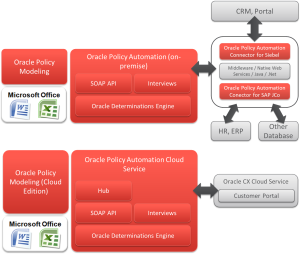Blog by Silvia Bujor
Oracle Intelligent Advisor and its Industry Use Cases
7 min read
 Contrary to common analyst creed that Oracle buy products and quickly stops innovation on them, Oracle have been pushing out new releases of its 10.4.x Oracle Policy Automation (OPA) offering. The 10.4.x line was initially released in June 2012 and its latest update is 10.4.3, dated May 2013.
Contrary to common analyst creed that Oracle buy products and quickly stops innovation on them, Oracle have been pushing out new releases of its 10.4.x Oracle Policy Automation (OPA) offering. The 10.4.x line was initially released in June 2012 and its latest update is 10.4.3, dated May 2013.
These releases have not only added functionality, but also allowed Oracle to deliver a strong business rules management solution on-premise and on the Cloud (starting with the February 2013 availability of the Oracle Policy Automation Cloud Service).
The OPA 10.4.x on-premise product line added the following functionality (from the 10.4.3 release notes):
Policy modelling outcomes can now be analysed and compared directly inside Microsoft Excel.
Policy models can be analysed to find gaps between test scripts and the rules that have been defined.
Policies may be modelled across multiple rulebase modules, easily sharing common polices across projects, divisions and systems.
The Data Source Connector has been re-envisaged as the Oracle Policy Automation Batch Processor. Database integration has been added to supplement the existing CSV processing.
The Oracle Policy Automation Batch Processor can create test cases from the input data it processes.
This is available in French, Italian, Portuguese (Brazilian), Simplified Chinese and Spanish.
Use rules to dynamically create new instances (such as benefits plans, tax years, or opportunities) to provide more intelligence assessments.
Deploy interviews to any supported JSR 286-compliant portal server
At runtime, compatible modules can be hot-swapped without the need to recompile the parent rulebase, minimizing maintenance overheads for commonly used modules.
Users may choose to apply a label to the compiled rulebase that can be retrieved by the runtime components.
This builds on top of OPA’s already quite comprehensive list of features, from which we highlight:
Sources:
Boxfusion Consulting has in-depth expertise in Oracle Policy Automation, having worked with it across a number of versions. If you are interested in understanding more about how Oracle Policy Automation could help you in your business, or require support with an implementation of OPA, we’d be happy to help – simply email us on [email protected] or call us on +44 203 283 4315.
7 min read
7 min read
In the age of heightened CX, OPA is quickly becoming a new industry standard....
6 min read